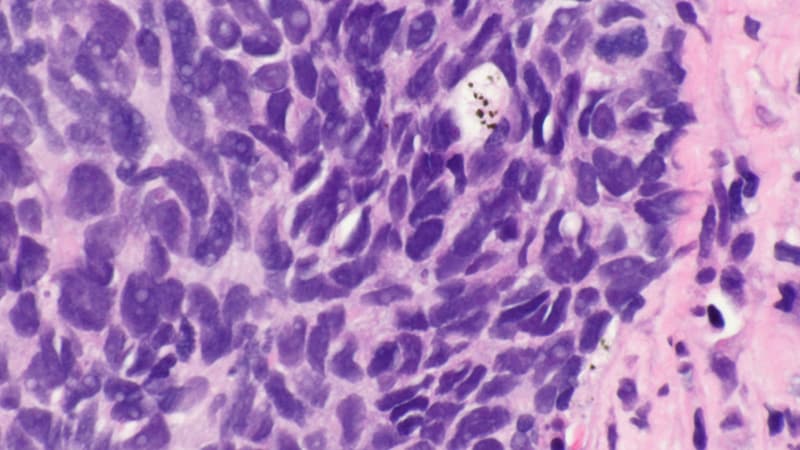Core Concepts
Liquid biopsy testing for ctDNA levels can predict survival outcomes in patients with oligometastatic NSCLC, guiding treatment decisions between consolidation radiotherapy and systemic therapy.
Abstract
The study presented at the American Society for Radiation Oncology annual meeting focused on the use of liquid biopsy testing to identify patients with oligometastatic NSCLC who would benefit from consolidation radiotherapy. Key highlights include:
- Liquid biopsy testing can distinguish between oligometastatic and micrometastatic disease.
- Detection of residual ctDNA before radiotherapy predicts worse progression-free survival and overall survival.
- Patients with detectable ctDNA had significantly worse survival outcomes compared to those with no detectable ctDNA.
- The study aimed to determine if liquid biopsy findings could help stratify disease severity in patients with oligometastatic NSCLC.
- The results were considered exciting and promising by the researchers and discussants.
Customize Summary
Rewrite with AI
Generate Citations
Translate Source
To Another Language
Generate MindMap
from source content
Visit Source
www.medscape.com
ctDNA Pre-Radiation Predicts Oligometastatic NSCLC Survival
Stats
Compared with no ctDNA, any level of residual ctDNA detected prior to radiotherapy predicted worse progression-free survival (PFS) and overall survival.
Detectable ctDNA in plasma predicted significantly worse median overall survival.
Maximum variant allele frequency level prior to radiotherapy predicted worse PFS and overall survival.
Quotes
"We have exciting real-world data that ctDNA detection and levels can risk-stratify oligometastatic NSCLC."
"This is what we've been looking for and waiting for in the oligometastatic disease space."
Key Insights Distilled From
by Neil Osterwe... at www.medscape.com 10-09-2023
https://www.medscape.com/viewarticle/997187
Deeper Inquiries
How can the use of liquid biopsy testing impact treatment decisions in other types of cancer?
Liquid biopsy testing can have a significant impact on treatment decisions in other types of cancer by providing a non-invasive method to detect and monitor tumor-derived genetic material, such as circulating tumor DNA (ctDNA). This technology allows for the assessment of tumor heterogeneity, evolution, and resistance mechanisms, which can help tailor treatment strategies to individual patients. In cancers where tissue biopsies are challenging to obtain or may not capture the full extent of the disease, liquid biopsies offer a more comprehensive and dynamic view of the tumor landscape. By analyzing ctDNA levels and genetic alterations, clinicians can make informed decisions about treatment selection, monitoring response to therapy, detecting minimal residual disease, and predicting disease recurrence. This personalized approach can lead to improved outcomes and better management of cancer patients across various cancer types.
What potential challenges or limitations could arise from relying on ctDNA levels for treatment decisions?
While liquid biopsy testing, specifically analyzing ctDNA levels, offers many advantages in cancer management, there are also potential challenges and limitations to consider. One key challenge is the sensitivity and specificity of ctDNA assays, as false positives or negatives can impact treatment decisions. Variability in ctDNA shedding, detection limits, and technical factors in sample collection and processing may introduce inaccuracies in the results. Additionally, the interpretation of ctDNA levels requires expertise in molecular biology and bioinformatics, which may not be readily available in all clinical settings. Another limitation is the potential for tumor heterogeneity and clonal evolution to affect the representation of the tumor genome in ctDNA, leading to incomplete or biased information. Furthermore, the cost of liquid biopsy testing and the need for validation in large clinical trials could pose financial and logistical challenges for widespread implementation in routine clinical practice.
How might advancements in liquid biopsy technology influence the future of cancer treatment strategies?
Advancements in liquid biopsy technology have the potential to revolutionize cancer treatment strategies by enabling precision medicine approaches and improving patient outcomes. As liquid biopsies become more sensitive, specific, and cost-effective, they can facilitate early cancer detection, monitoring of treatment response, detection of minimal residual disease, and identification of emerging resistance mechanisms. By capturing the dynamic changes in tumor genetics over time, liquid biopsies can guide treatment decisions, such as selecting targeted therapies, monitoring treatment efficacy, and adjusting therapy in real-time based on molecular alterations. The integration of liquid biopsy data with imaging, clinical parameters, and other biomarkers can enhance the understanding of tumor biology and help optimize treatment regimens for individual patients. In the future, liquid biopsy technology may enable more personalized and precise cancer care, leading to improved survival rates, reduced toxicity from treatments, and better quality of life for cancer patients.
0
